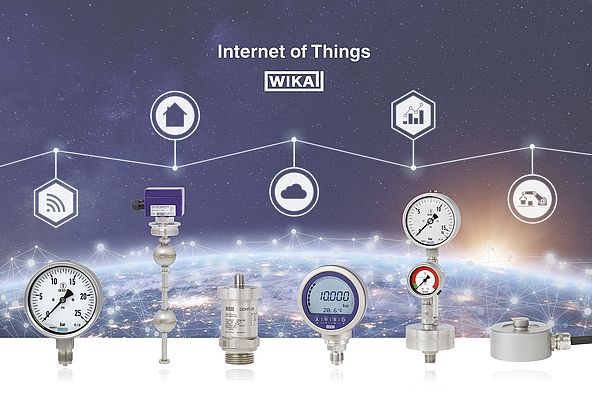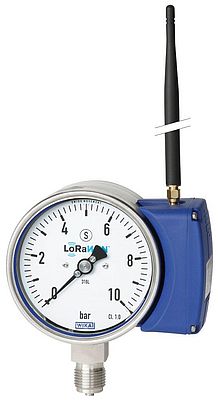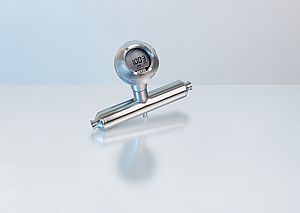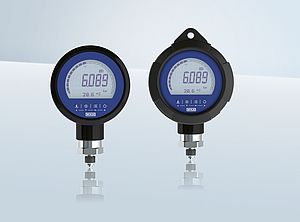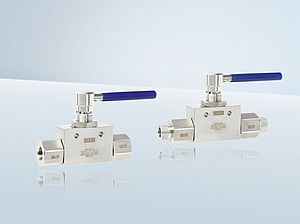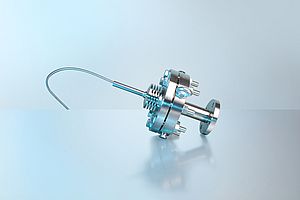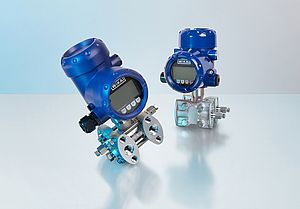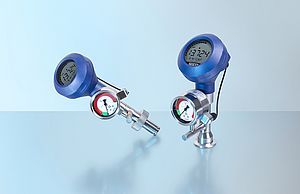Everything is interconnected. Connectivity is what makes the Internet of Things work. Standardised communication between all devices and systems provides the input for the real added value of digitised processes: this information, together with analysis tools, enables operators to optimise their processes in terms of quality, productivity and costs.
However, that is only possible if all process data can be accessed independently of the manufacturer. Suppliers of measuring equipment must therefore offer a standardised method of data exchange across different platforms. Apart from the measured values, this concerns all specific information from connected devices that is required to generate a digital twin and allow more extensive planning and analyses.
Bidirectional data exchange
The idea is that, in future, WIKA customers will be able to purchase a system solution, which is why a central platform with open standards is being developed parallel to IIoT-compatible measuring instruments. Bidirectional data exchange, both with the sensor level (measuring instrument) and with customer systems, will then become reality. This platform will also be utilised by the oil company whose well monitoring system is being digitised by WIKA at a site in northern Germany.
The project was triggered by a change in the German Mining Act. The amended version of this act stipulates continuous data acquisition at all extraction points. The policy until now has been for employees to drive to each individual point at intervals, then read off and make a note of the instrument values as well as the water level in the wells – a costly and time-consuming procedure. If an oil field has more than one well, safety features are controlled by means of a process control system – a local solution with no connection to the outside. Once again, a human being has to carry out regular on-the-spot inspections.
In theory, it would be perfectly possible to transmit the data from all extraction points to a central control room via cable. However, laying the necessary cables over such a long distance would have a significant environmental impact and it would not make business sense either.
Cost-effective solution
The uniform concept developed by WIKA for all extraction points complies with all regulations, so that there is no need to have the operating license amended. At the same time, it represents a cost-effective solution for the customer: many oil fields have only a limited operational life remaining and the budget for investments must not be out of proportion. The digitised well monitoring system is economically feasible despite the tight financial constraints.
In the past, exclusively mechanical measuring instruments have been used at the extraction points to obtain data as the basis for plant monitoring. The operator wishes to keep this on-site option alongside online monitoring as an alternative requiring no external power, particularly for pressure and temperature, which are the two most crucial parameters. When the digitised monitoring system is installed, therefore, the existing devices will be replaced with WIKA models from the “intelliGAUGE” and “intelliTHERM” series, which are designed with both an electrical output (4…20 mA) and an on-site display. On the other hand, the level in the storage tank at the well will in future be recorded using a float switch with a 4…20 mA signal.
All devices are connected to a local gateway in the plant via their electrical outputs. This gateway transmits the data from the measuring points to the central system platform using an LPWAN (Low Power Wide Area Network) wireless standard. In the case of pressure, temperature and level measuring instruments, only a relatively small amount of information per day has to be transmitted. The battery for operating the wireless module has a service life of up to ten years for this reason, so that installation and maintenance costs are reduced to a minimum.
LoRaWAN and MIOTY
WIKA generally favours LoRaWAN or MIOTY as the wireless standard for its IIoT devices. Both standards transmit on a public band (868 MHz) that can be used by approved devices without a license. Distances of 30 kilometres or more can be covered in this way, depending on the topography. The standards are thus also ideal for locations with a weak mobile signal.
LoRaWAN is already well-established in the market. WIKA uses this standard as well, to integrate classic display instruments into digitised processes. The manufacturer’s portfolio will soon include a pressure gauge integrating a type PWG23 LoRa module – the first in a new series of mechanical LPWAN devices. It has a microprocessor that converts the measured value transmitted by the Bourdon tube into a radio signal.
Besides LPWAN solutions, WIKA’s planning also takes account of wireless standards which were integrated by the manufacturer in a previous measurement solution for monitoring decentralised tank plants. Dynamic processes with a large number of measured values must have sufficient bandwidth and power output – in other words, a mains supply – in order to transmit data once a second. Systems are also conceivable where many low power data transmissions are concentrated at a single wireless node and bundled. MIOTY, widely held to be the next generation of LPWAN technology which the oil company is pioneering in field use, was selected as the wireless standard for this particular well project. Developed by the Fraunhofer Institute for Integrated Circuits IIS, the MIOTY standard works with telegram splitting technology, which guarantees stable data transmission and a low error rate. What’s more, MIOTY is extremely scalable. Even networks with a very large number of devices and only one receiver can be operated without any deterioration in quality.
The operator of the oil production facility decided in favour of the new low power standard chiefly because it offers such excellent network stability. All status information can also be transmitted to a smartphone as text messages or emails, so that a person on standby can take immediate action should a fault occur.
Data based plant control
As well as being able to demonstrate the plant’s safety to relevant authorities and customers, the operator can also reap enormous benefits from the IIoT solution. All processes are controlled on demand based on the data, so that on-the-spot inspections and other assignments are confined to an essential minimum. Tomorrow’s oil production will be determined by actual well parameters, with no more losses due to inefficient operation. In a second phase, a feature for switching off the well automatically will likewise be integrated into the system.
The platform also supports condition-based maintenance. Maintenance and replacements no longer take place at fixed intervals but are based solely on data-driven decisions. Not only will this strategy save money; errors will be virtually eliminated as a result.


